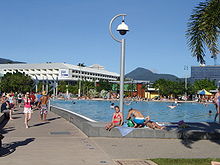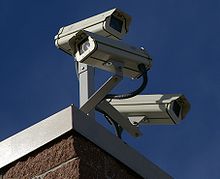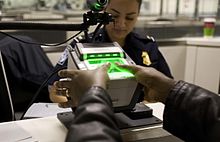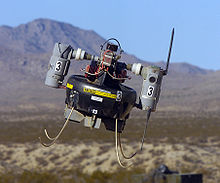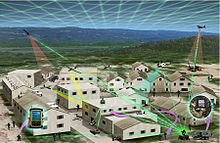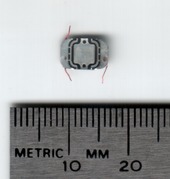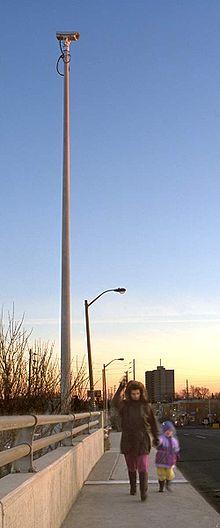- Surveillance
-
Surveillance (
 /sərˈveɪ.əns/ or /sərˈveɪləns/)[1] is the monitoring of the behavior, activities, or other changing information, usually of people. It is sometimes done in a surreptitious manner. It most usually refers to observation of individuals or groups by government organizations, but disease surveillance, for example, is monitoring the progress of a disease in a community.
/sərˈveɪ.əns/ or /sərˈveɪləns/)[1] is the monitoring of the behavior, activities, or other changing information, usually of people. It is sometimes done in a surreptitious manner. It most usually refers to observation of individuals or groups by government organizations, but disease surveillance, for example, is monitoring the progress of a disease in a community.The word surveillance is the French word for "watching over".
The word surveillance may be applied to observation from a distance by means of electronic equipment (such as CCTV cameras), or interception of electronically transmitted information (such as Internet traffic or phone calls). It may also refer to simple, relatively no- or low-technology methods such as human intelligence agents and postal interception.
Surveillance is very useful to governments and law enforcement to maintain social control, recognize and monitor threats, and prevent/investigate criminal activity. With the advent of programs such as the Total Information Awareness program and ADVISE, technologies such as high speed surveillance computers and biometrics software, and laws such as the Communications Assistance For Law Enforcement Act, governments now possess an unprecedented ability to monitor the activities of their subjects.[2]
However, many civil rights and privacy groups such as the Electronic Frontier Foundation and American Civil Liberties Union have expressed concern that by allowing continual increases in government surveillance of citizens that we will end up in a mass surveillance society, with extremely limited, or non-existent political and/or personal freedoms. Fears such as this have led to numerous lawsuits such as Hepting v. AT&T.[2][3]
Types of surveillance
Computer surveillance
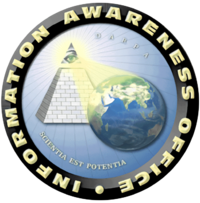 Official seal of the Information Awareness Office -- a U.S. agency which developed technologies for mass surveillance
Official seal of the Information Awareness Office -- a U.S. agency which developed technologies for mass surveillance
The vast majority of computer surveillance involves the monitoring of data and traffic on the Internet.[4] In the United States for example, under the Communications Assistance For Law Enforcement Act, all phone calls and broadband Internet traffic (emails, web traffic, instant messaging, etc.) are required to be available for unimpeded real-time monitoring by Federal law enforcement agencies.[5][6][7]
There is far too much data on the Internet for human investigators to manually search through all of it. So automated Internet surveillance computers sift through the vast amount of intercepted Internet traffic and identify and report to human investigators traffic considered interesting by using certain "trigger" words or phrases, visiting certain types of web sites, or communicating via email or chat with suspicious individuals or groups.[8] Billions of dollars per year are spent, by agencies such as the Information Awareness Office, NSA, and the FBI, to develop, purchase, implement, and operate systems such as Carnivore, NarusInsight, and ECHELON to intercept and analyze all of this data, and extract only the information which is useful to law enforcement and intelligence agencies.[9]
Computers are also a surveillance target because of the personal data stored on them. If someone is able to install software (either physically or remotely), such as the FBI's "Magic Lantern" and CIPAV, on a computer system, they can easily gain unauthorized access to this data.[10]
Another form of computer surveillance, known as TEMPEST, involves reading electromagnetic emanations from computing devices in order to extract data from them at distances of hundreds of meters.[11][12][13]
The NSA also runs a database known as "Pinwale", which stores and indexes large numbers of emails of both American citizens and foreigners.[14][15]
Telephones
The official and unofficial tapping of telephone lines is widespread. In the United States for instance, the Communications Assistance For Law Enforcement Act (CALEA) requires that all telephone and VoIP communications be available for real-time wiretapping by Federal law enforcement and intelligence agencies.[5][6][7] Two major telecommunications companies in the U.S. -- AT&T and Verizon—have contracts with the FBI, requiring them to keep their phone call records easily searchable and accessible for Federal agencies, in return for $1.8 million dollars per year.[16] Between 2003 and 2005, the FBI sent out more than 140,000 "National Security Letters" ordering phone companies to hand over information about their customers' calling and Internet histories. About half of these letters requested information on U.S. citizens.[17]
Human agents are not required to monitor most calls. Speech-to-text software creates machine-readable text from intercepted audio, which is then processed by automated call-analysis programs, such as those developed by agencies such as the Information Awareness Office, or companies such as Verint, and Narus, which search for certain words or phrases, to decide whether to dedicate a human agent to the call.[18]
Law enforcement and intelligence services in the U.K. and the United States possess technology to remotely activate the microphones in cell phones, by accessing the phone's diagnostic/maintenance features, in order to listen to conversations that take place nearby the person who holds the phone.[19][20][21][22][23][24]
Mobile phones are also commonly used to collect location data. The geographical location of a mobile phone (and thus the person carrying it) can be determined easily (whether it is being used or not), using a technique known multilateration to calculate the differences in time for a signal to travel from the cell phone to each of several cell towers near the owner of the phone.[25][26] A controversy has emerged in the United States over the legality of such techniques, and particularly whether a court warrant is required.[27] Records for one carrier alone (Sprint), showed that in a given year federal law enforcement agencies requested customer location data 8 million times.[28]
Surveillance cameras
Surveillance cameras are video cameras used for the purpose of observing an area. They are often connected to a recording device, IP network, and/or watched by a security guard/law enforcement officer. Cameras and recording equipment used to be relatively expensive and required human personnel to monitor camera footage. Now with cheaper production techniques, it is simple and inexpensive enough to be used in home security systems, and for everyday surveillance. Analysis of footage is made easier by automated software that organizes digital video footage into a searchable database, and by automated video analysis software (such as VIRAT and HumanID) . The amount of footage is also drastically reduced by motion sensors which only record when motion is detected.
The use of surveillance cameras by governments and businesses has dramatically increased over the last 10 years. In the U.K., for example, there are about 4.2 million surveillance cameras—1 camera for every 14 people.[29]
In the United States, the Department of Homeland Security gives billions of dollars per year in Homeland Security grants for local, state, and federal agencies to install modern video surveillance equipment. For example, the city of Chicago, IL recently used a $5.1 million Homeland Security grant to install an additional 250 surveillance cameras, and connect them to a centralized monitoring center, along with its preexisting network of over 2000 cameras in a program known as Operation Virtual Shield. Chicago Mayor Richard Daley has announced that Chicago will have a surveillance camera on every street corner by the year 2016.[30][31]
As part of China's Golden Shield Project, several U.S. corporations such as IBM, General Electric, and Honeywell have been working closely with the Chinese government to install millions of surveillance cameras throughout China, along with advanced video analytics and facial recognition software, which will identify and track individuals everywhere they go. They will be connected to a centralized database and monitoring station, which will, upon completion of the project, contain a picture of the face of every person in China: over 1.3 billion people.[32] Lin Jiang Huai, the head of China's "Information Security Technology" office (which is in charge of the project), credits the surveillance systems in the United States and the U.K. as the inspiration for what he is doing with the Golden Shield project.[32]
 Payload surveillance camera manufactured by Controp and distributed to the U.S. Government by ADI Technologies.
Payload surveillance camera manufactured by Controp and distributed to the U.S. Government by ADI Technologies.
The Defense Advanced Research Projects Agency (DARPA) is funding a research project called Combat Zones That See that will link up cameras across a city to a centralized monitoring station, identify and track individuals and vehicles as they move through the city, and report "suspicious" activity (such as waving arms, looking side-to-side, standing in a group, etc.).[33]
At Super Bowl XXXV in January 2001, police in Tampa Bay, Florida, used Identix’s facial recognition software, FaceIt, to scan the crowd for potential criminals and terrorists in attendance at the event.[34] (it found 19 people with pending arrest warrants)[35]
Governments often initially claim that cameras are meant to be used for traffic control, but many of them end up using them for general surveillance. For example, Washington, D.C. had 5000 "traffic" cameras installed under this premise, and then after they were all in place, networked them all together and then granted access to the Metropolitan Police Department, so that they could perform "day-to-day monitoring".[36]
The development of centralized networks of CCTV cameras watching public areas—linked to computer databases of people's pictures and identity (biometric data), able to track peoples' movements throughout the city, and identify who they have been with—has been argued by some to present a risk to civil liberties.[37]
Social network analysis
One common form of surveillance is to create maps of social networks based on data from social networking sites such as Facebook, MySpace, Twitter as well as from traffic analysis information from phone call records such as those in the NSA call database,[38] and others. These social network "maps" are then data mined to extract useful information such as personal interests, friendships & affiliations, wants, beliefs, thoughts, and activities.[39][40][41][42]
Many U.S. government agencies such as the Defense Advanced Research Projects Agency (DARPA), the National Security Agency (NSA), and the Department of Homeland Security (DHS) are investing heavily in research involving social network analysis.[43][44] The intelligence community believes that the biggest threat to U.S. power comes from decentralized, leaderless, geographically dispersed groups of terrorists, subversives, extremists, and dissidents. These types of threats are most easily countered by finding important nodes in the network, and removing them. To do this requires a detailed map of the network.[41][42][45][46]
Jason Ethier of Northeastern University, in his study of modern social network analysis, said the following of the Scalable Social Network Analysis Program developed by the Information Awareness Office:
The purpose of the SSNA algorithms program is to extend techniques of social network analysis to assist with distinguishing potential terrorist cells from legitimate groups of people.... In order to be successful SSNA will require information on the social interactions of the majority of people around the globe. Since the Defense Department cannot easily distinguish between peaceful citizens and terrorists, it will be necessary for them to gather data on innocent civilians as well as on potential terrorists.AT&T developed a programming language called "Hancock" which is able to sift through enormous databases of phone call and Internet traffic records, such as the NSA call database and extract "communities of interest" -- groups of people who call each other regularly, or groups that regularly visit certain sites on the Internet. AT&T originally built the system to develop "marketing leads",[47] but the FBI has regularly requested such information from phone companies such as AT&T without a warrant,[47] and after using the data stores all information received in its own databases, regardless of whether or not the information was ever useful in an investigation.[48]
Some people believe that the use of social networking sites is a form of "participatory surveillance", where users of these sites are essentially performing surveillance on themselves, putting detailed personal information on public websites where it can be viewed by corporations and governments.[39] About 20% of employers have reported using social networking sites to collect personal data on prospective or current employees.[49]
Biometric surveillance
Biometric surveillance refers to technologies that measure and analyze human physical and/or behavioral characteristics for authentication, identification, or screening purposes.[50] Examples of physical characteristics include fingerprints, DNA, and facial patterns. Examples of mostly behavioral characteristics include gait (a person's manner of walking) or voice.
Facial recognition is the use of the unique configuration of a person's facial features to accurately identify them, usually from surveillance video. Both the Department of Homeland Security and DARPA are heavily funding research into facial recognition systems.[51] The Information Processing Technology Office, ran a program known as Human Identification at a Distance which developed technologies that are capable of identifying a person at up to 500 ft by their facial features.
Another form of behavioral biometrics, based on affective computing, involves computers recognizing a person's emotional state based on an analysis of their facial expressions, how fast they are talking, the tone and pitch of their voice, their posture, and other behavioral traits. This might be used for instance to see if a person is acting "suspicious" (looking around furtively, "tense" or "angry" facial expressions, waving arms, etc.).[52]
A more recent development is DNA fingerprinting, which looks at some of the major markers in the body's DNA to produce a match. The FBI is spending $1 billion to build a new biometric database, which will store DNA, facial recognition data, iris/retina (eye) data, fingerprints, palm prints, and other biometric data of people living in the United States. The computers running the database are contained in an underground facility about the size of two American football fields.[53][54][55]
The Los Angeles Police Department is installing automated facial recognition and license plate recognition devices in its squad cars, and providing handheld face scanners, which officers will use to identify people while on patrol.[56][57][58]
Facial thermographs are in development, which allow machines to identify certain emotions in people such as fear or stress, by measuring the temperature generated by blood flow to different parts of their face.[59] Law enforcement officers believe that this has potential for them to identify when a suspect is nervous, which might indicate that they are hiding something, lying, or worried about something.[59]
Aerial surveillance
Aerial surveillance is the gathering of surveillance, usually visual imagery or video, from an airborne vehicle—such as a unmanned aerial vehicle, helicopter, or spy plane. Military surveillance aircraft use a range of sensors (e.g. radar) to monitor the battlefield.
Digital imaging technology, miniaturized computers, and numerous other technological advances over the past decade have contributed to rapid advances in aerial surveillance hardware such as micro-aerial vehicles, forward-looking infrared, and high-resolution imagery capable of identifying objects at extremely long distances. For instance, the MQ-9 Reaper,[60] a U.S. drone plane used for domestic operations by the Department of Homeland Security, carries cameras that are capable of identifying an object the size of a milk carton from altitudes of 60,000 feet, and has forward-looking infrared devices that can detect the heat from a human body at distances of up to 60 kilometers.[61]
The United States Department of Homeland Security is in the process of testing UAVs to patrol the skies over the United States for the purposes of critical infrastructure protection, border patrol, "transit monitoring", and general surveillance of the U.S. population.[62] Miami-Dade police department ran tests with a vertical take-off and landing UAV from Honeywell, which is planned to be used in SWAT operations.[63] Houston's police department has been testing fixed-wing UAVs for use in "traffic control".[63]
The United Kingdom, as well, is working on plans to build up a fleet of surveillance UAVs ranging from micro-aerial vehicles to full-size drones, to be used by police forces throughout the U.K.[64]
In addition to their surveillance capabilities, MAVs are capable of carrying tasers for "crowd control", or weapons for killing enemy combatants.[65]
Programs such as the Heterogenous Aerial Reconnaissance Team program developed by DARPA have automated much of the aerial surveillance process. They have developed systems consisting of large teams drone planes that pilot themselves, automatically decide who is "suspicious" and how to go about monitoring them, coordinate their activities with other drones nearby, and notify human operators if something suspicious is occurring. This greatly increases the amount of area that can be continuously monitored, while reducing the number of human operators required. Thus a swarm of automated, self-directing drones can automatically patrol a city and track suspicious individuals, reporting their activities back to a centralized monitoring station.[66][67][68]
Data mining and profiling
Data mining is the application of statistical techniques and programmatic algorithms to discover previously unnoticed relationships within the data.. Data profiling in this context is the process of assembling information about a particular individual or group in order to generate a profile — that is, a picture of their patterns and behavior. Data profiling can be an extremely powerful tool for psychological and social network analysis. A skilled analyst can discover facts about a person that they might not even be consciously aware of themselves.[69]
Economic (such as credit card purchases) and social (such as telephone calls and emails) transactions in modern society create large amounts of stored data and records. In the past this data would be documented in paper records and would leave a "paper trail", or simply not be documented at all. Correlation of paper-based records was a laborious process—it required human intelligence operators to manually dig through documents, which was time-consuming and incomplete, at best.
But today many of these records are electronic, resulting in an "electronic trail". Every use of a bank machine, payment by credit card, use of a phone card, call from home, checked out library book, rented video, or otherwise complete recorded transaction generates an electronic record. Public records—such as birth, court, tax and other records—are increasily being digitized and made available online. In addition, due to laws like CALEA, web traffic and online purchases are also available for profiling. Electronic record-keeping makes data easily collectable, storable, and accessible—so that high-volume, efficient aggregation and analysis is possible at significantly lower costs.
Information relating to many of these individual transactions is often easily available because it is not generally not guarded in isolation, since the information, such as the title of a movie a person has rented, might not seem sensitive. However, when many such transactions are aggregated they can be used to assemble a detailed profile revealing the actions, habits, beliefs, locations frequented, social connections, and preferences of the individual. This profile is then used, by programs such as ADVISE [70] and TALON, to determine whether the person is a military, criminal, or political threat.
In addition to its own aggregation and profiling tools, the government is able to access information from third parties — for example, banks, credit companies or employers, etc. — by requesting access informally, by compelling access through the use of subpoenas or other procedures,[71] or by purchasing data from commercial data aggregators or data brokers. The United States has spent $370 million on its 43 planned fusion centers, which are national network of surveillance centers that are located in over 30 states. The centers will collect and analyze vast amounts of data on U.S. citizens. It will get this data by consolidating personal information from sources such as state driver's licensing agencies, hospital records, criminal records, school records, credit bureaus, banks, etc. -- and placing this information in a centralized database that can be accessed from all of the centers, as well as other federal law enforcement and intelligence agencies.[72]
Under United States v. Miller (1976), data held by third parties is generally not subject to Fourth Amendment warrant requirements.
Corporate surveillance
Corporate surveillance is the monitoring of a person or group's behavior by a corporation. The data collected is most often used for marketing purposes or sold to other corporations, but is also regularly shared with government agencies. It can be used as a form of business intelligence, which enables the corporation to better tailor their products and/or services to be desirable by their customers. Or the data can be sold to other corporations, so that they can use it for the aforementioned purpose. Or it can be used for direct marketing purposes, such as the targeted advertisements on Google and Yahoo, where ads are targeted to the user of the search engine by analyzing their search history and emails[73] (if they use free webmail services), which is kept in a database.[74]
For instance, Google, the world's most popular search engine, stores identifying information for each web search. An IP address and the search phrase used are stored in a database for up to 18 months.[75] Google also scans the content of emails of users of its Gmail webmail service, in order to create targeted advertising based on what people are talking about in their personal email correspondences.[76] Google is, by far, the largest Internet advertising agency—millions of sites place Google's advertising banners and links on their websites, in order to earn money from visitors who click on the ads. Each page containing Google ads adds, reads, and modifies "cookies" on each visitor's computer.[77] These cookies track the user across all of these sites, and gather information about their web surfing habits, keeping track of which sites they visit, and what they do when they are on these sites. This information, along with the information from their email accounts, and search engine histories, is stored by Google to use for building a profile of the user to deliver better-targeted advertising.[76]
The United States government often gains access to these databases, either by producing a warrant for it, or by simply asking. The Department of Homeland Security has openly stated that it uses data collected from consumer credit and direct marketing agencies—such as Google—for augmenting the profiles of individuals that it is monitoring.[74] The FBI, Department of Homeland Security, and other intelligence agencies have formed an "information-sharing" partnership with over 34,000 corporations as part of their Infragard program.
The U.S. Federal government has gathered information from grocery store "discount card" programs, which track customers' shopping patterns and store them in databases, in order to look for "terrorists" by analyzing shoppers' buying patterns.[78]
Human operatives
Organizations that have enemies who wish to gather information about the groups members or activities face the issue of infiltration.[79][80]
In addition to operatives infiltrating an organization, the surveilling party may put pressure on certain members of the target organization to act as informants (i.e. disclose the information they hold on the organization and its members).[81][82]
Fielding operatives is very expensive, and for governments with wide-reaching electronic surveillance tools at their disposal the information recovered from operatives can often be obtained from less problematic forms of surveillance such as those mentioned above. Nevertheless, human infiltrators are still common today. For instance, in 2007 documents surfaced showing that the FBI was planning to field a total of 15,000 undercover agents and informants in response to an anti-terrorism directive sent out by George W. Bush in 2004 that ordered intelligence and law enforcement agencies to increase their HUMINT capabilities.[83]
Satellite imagery
On May 25, 2007 the U.S. Director of National Intelligence Michael McConnell authorized the National Applications Office (NAO) of the Department of Homeland Security to allow local, state, and domestic Federal agencies to access imagery from military intelligence satellites and aircraft sensors which can now be used to observe the activities of U.S. citizens. The satellites and aircraft sensors will be able to penetrate cloud cover, detect chemical traces, and identify objects in buildings and "underground bunkers", and will provide real-time video at much higher resolutions than the still-images produced by programs such as Google Earth.[84][85][86][87][88][89]
Identification and credentials
 A card containing an identification number
A card containing an identification number
One of the simplest forms of identification is the carrying of credentials. Some nations have an identity card system to aid identification, whilst many, such as Britain, are considering it but face public opposition. Other documents, such as passports, driver's licenses, library cards, bankers or credit cards are also used to verify identity.
If the form of the identity card is "machine-readable," usually using an encoded magnetic stripe or identification number (such as a Social Security number) that corroborates the subject's identifying data. In this case it may create a document trail when it is checked and scanned, which can be used in profiling, as mentioned above.
RFID and geolocation devices
RFID tagging
Radio Frequency Identification (RFID) tagging is the use of very small electronic devices (called 'RFID tags') which are applied to or incorporated into a product, animal, or person for the purpose of identification and tracking using radio waves. The tags can be read from several meters away. They are extremely cheap, costing a few cents a piece, so they can be inserted into many types of everyday products without significantly increasing the price, and can be used to track and identify these objects for a variety of purposes.
Many companies are already "tagging" their workers, who are monitored while on the job. Workers in U.K. went on general strike in protest of having themselves tagged. They felt that it was dehumanizing to have all of their movements tracked with RFID chips.[90] Some critics have expressed fears that people will soon be tracked and scanned everywhere they go.[91]
Verichip is an RFID device produced by a company called Applied Digital Solutions (ADS). Verichip is slightly larger than a grain of rice, and is injected under the skin. The injection reportedly feels similar to receiving a shot. The chip is encased in glass, and stores a "VeriChip Subscriber Number" which the scanner uses to access their personal information, via the Internet, from Verichip Inc.'s database, the "Global VeriChip Subscriber Registry". Thousands of people have already had them inserted.[91] In Mexico, for example, 160 workers at the Attorney General's office were required to have the chip injected for identity verification and access control purposes.[92][93]
It may be that soon every object that is purchased, and perhaps ID cards, will have RFID devices in them, which would broadcast information about people as they walk past scanners (what type of phone they have, what type of shoes they have on, which books they are carrying, what credit cards or membership cards they have, etc.). This information could be used for identification, tracking, or targeted marketing.[94]
Global Positioning System
In the U.S., police have planted hidden GPS tracking devices in people's vehicles to monitor their movements, without a warrant. In early 2009 they were arguing in court that they have the right to do this.[95]
Several cities are running pilot projects to require parolees to wear GPS devices to track their movements when they get out of prison.[96]
Mobile phones
Mobile phones are also commonly used to collect geolocation data. The geographical location of a mobile phone (and thus the person carrying it) can be determined easily (whether it is being used or not), using a technique known multilateration to calculate the differences in time for a signal to travel from the cell phone to each of several cell towers near the owner of the phone.[25][26]
Surveillance devices
Surveillance devices, or "bugs", are hidden electronic devices which are used to capture, record, and/or transmit data to a receiving party such as a law enforcement agency.
The U.S. has run numerous domestic intelligence, such as COINTELPRO, which have bugged the homes, offices, and vehicles of thousands of U.S. citizens, usually political activists, subversives, and criminals.[97]
Law enforcement and intelligence services in the U.K. and the United States possess technology to remotely activate the microphones in cell phones, by accessing the phone's diagnostic/maintenance features, in order to listen to conversations that take place nearby the person who holds the phone.[20][21][22]
Postal services
As more people use faxes and e-mail the significance of surveilling the postal system is decreasing, in favor of Internet and telephone surveillance. But interception of post is still an available option for law enforcement and intelligence agencies, in certain circumstances.
The U.S. Central Intelligence Agency and Federal Bureau of Investigation have performed twelve separate mail-opening campaigns targeted towards U.S. citizens. In one of these programs, more than 215,000 communications were intercepted, opened, and photographed.[98][99]
Controversy surrounding surveillance
Support
Some supporters of surveillance systems believe that these tools protect society from terrorists and criminals. Other supporters simply believe that there is nothing that can be done about it, and that people must become accustomed to having no privacy. As Sun Microsystems CEO Scott McNealy said: "You have zero privacy anyway. Get over it."[100][101]
Another common argument is: "If you aren't doing something wrong then you don't have anything to fear." Which follows that if you are engaging in unlawful activities, in which case you do not have a legitimate justification for your privacy. However, if you are following the law the surveillance would not affect you.[102]
Opposition
Some critics state that the claim made by supporters should be modified to read: "As long as we do what we're told, we have nothing to fear.". For instance, a person who is part of a political group which opposes the policies of the national government, might not want the government to know their names and what they have been reading, so that the government cannot easily subvert their organization, arrest, or kill them. Other critics state that while a person might not have anything to hide right now, the government might later implement policies that they do wish to oppose, and that opposition might then be impossible due to mass surveillance enabling the government to identify and remove political threats. Further, other critics point to the fact that most people do have things to hide. For example, if a person is looking for a new job, they might not want their current employer to know this.
Totalitarianism
Programs such as the Total Information Awareness program, and laws such as the Communications Assistance For Law Enforcement Act have led many groups to fear that society is moving towards a state of mass surveillance with severely limited personal, social, political freedoms, where dissenting individuals or groups will be strategically removed in COINTELPRO-like purges.[2][3][29]
Kate Martin, of the Center For National Security Studies said of the use of military spy satellites being used to monitor the activities of U.S. citizens: "They are laying the bricks one at a time for a police state."[88]
Some point to the blurring of lines between public and private places, and the privatization of places traditionally seen as public (such as shopping malls and industrial parks) as illustrating the increasing legality of collecting personal information.[103] Traveling through many public places such as government offices is hardly optional for most people, yet consumers have little choice but to submit to companies' surveillance practices.[104] Surveillance techniques are not created equal; among the many biometric identification technologies, for instance, face recognition requires the least cooperation. Unlike automatic fingerprint reading, which requires an individual to press a finger against a machine, this technique is subtle and requires little to no consent. [104]
Psychological/social effects
Some critics, such as Michel Foucault, believe that in addition to its obvious function of identifying and capturing individuals who are committing undesirable acts, surveillance also functions to create in everyone a feeling of always being watched, so that they become self-policing. This allows the State to control the populace without having to resort to physical force, which is expensive and otherwise problematic.[105]
Privacy
Numerous civil rights groups and privacy groups oppose surveillance as a violation of people's right to privacy. Such groups include: Electronic Privacy Information Center, Electronic Frontier Foundation, American Civil Liberties Union
There have been several lawsuits such as Hepting v. AT&T and EPIC v. Department of Justice by groups or individuals, opposing certain surveillance activities.
Legislative proceedings such as those that took place during the Church Committee, which investigated domestic intelligence programs such as COINTELPRO, have also weighed the pros and cons of surveillance.
Countersurveillance, inverse surveillance, sousveillance
Countersurveillance is the practice of avoiding surveillance or making surveillance difficult. With recent developments — the Internet, increasing prevalence of electronic security systems, armed UAVs flying at 60,000 feet, and large corporate/government computer databases — counter surveillance has dramatically grown in scope and complexity.
Inverse surveillance is the practice of reversalism on surveillance (e.g., citizens photographing police). Well-known examples are George Holliday's recording of the Rodney King beating and the organization Copwatch, which attempts to surveil police officers to prevent police brutality.
Sousveillance (a term coined by Steve Mann, a professor at the University of Toronto) is inverse surveillance that includes the recording of an activity by a participant in the activity.[106]
In popular culture
In literature
- George Orwell's novel, 1984, portrays a fictional totalitarian surveillance society which has a very simple (by today's standards) mass surveillance system consisting of human operatives, informants, and two-way "telescreens" in people's homes. Because of the impact of this book, "Orwellian" is a common term used to describe mass surveillance technologies.
- The book, The Handmaid's Tale as well as a film based on it, portray a totalitarian Christian theocracy where all citizens are kept under constant surveillance.
In music
- The Dead Kennedys' song, "I Am The Owl", is about government surveillance and social engineering of political groups.
Onscreen
- The movie, Gattaca, portrays a society that uses biometric surveillance to distinguish between people who are genetically engineered "superior" humans and genetically natural "inferior" humans.
- In the movie Minority Report, the police and government intelligence agencies use micro aerial vehicles in SWAT operations and for surveillance purposes.
- HBO's crime-drama series, The Sopranos, regularly portrays the FBI's surveillance of the DiMeo Crime Family. Audio devices they use include "bugs" placed in strategic locations (e.g., in "I Dream of Jeannie Cusamano" and "Mr. Ruggerio's Neighborhood") and hidden microphones worn by operatives (e.g., in "Rat Pack") and informants (e.g., in "Funhouse", "Proshai, Livushka", and "Members Only"). Visual devices include hidden still cameras (e.g., in "Pax Soprana") and video cameras (e.g., in "Long Term Parking").
- The movie, THX-1138, portrays a society where people are drugged with sedatives and antidepressants, and have surveillance cameras watching them everywhere they go.
See also
- Signals intelligence
- Big Brother Watch
- COINTELPRO
- Communications Assistance For Law Enforcement Act
- Hepting v. AT&T
- Heterogeneous Aerial Reconnaissance Team
- NSA warrantless surveillance
- Surveillance art
- Surveillance system monitor
References
- ^ OED
- ^ a b c "Is the U.S. Turning Into a Surveillance Society?". American Civil Liberties Union. http://www.aclu.org/privacy/gen/index.html. Retrieved 2009-03-13.
- ^ a b "Bigger Monster, Weaker Chains: The Growth of an American Surveillance Society". American Civil Liberties Union. January 15, 2003. http://www.aclu.org/FilesPDFs/aclu_report_bigger_monster_weaker_chains.pdf. Retrieved 2009-03-13.
- ^ Diffie, Whitfield; Susan Landau (August, 2008). "Internet Eavesdropping: A Brave New World of Wiretapping". Scientific American. http://www.sciam.com/article.cfm?id=internet-eavesdropping. Retrieved 2009-03-13.
- ^ a b "CALEA Archive -- Electronic Frontier Foundation". Electronic Frontier Foundation (website). http://w2.eff.org/Privacy/Surveillance/CALEA/?f=archive.html. Retrieved 2009-03-14.
- ^ a b "CALEA: The Perils of Wiretapping the Internet". Electronic Frontier Foundation (website). http://www.eff.org/issues/calea. Retrieved 2009-03-14.
- ^ a b "CALEA: Frequently Asked Questions". Electronic Frontier Foundation (website). http://www.eff.org/pages/calea-faq. Retrieved 2009-03-14.
- ^ Hill, Michael (October 11, 2004). "Government funds chat room surveillance research". Associated Press (USA Today). http://www.usatoday.com/tech/news/surveillance/2004-10-11-chatroom-surv_x.htm. Retrieved 2009-03-19.
- ^ McCullagh, Declan (January 30, 2007). "FBI turns to broad new wiretap method". ZDNet News. http://news.zdnet.com/2100-9595_22-151059.html. Retrieved 2009-03-13.
- ^ "FBI's Secret Spyware Tracks Down Teen Who Made Bomb Threats". Wired Magazine. 2007-07-18. http://www.wired.com/politics/law/news/2007/07/fbi_spyware.
- ^ McNamara, Joel. "Complete, Unofficial Tempest Page". http://www.eskimo.com/~joelm/tempest.html. Retrieved 2009-03-12.
- ^ Van Eck, Wim (1985). "Electromagnetic Radiation from Video Display Units: An Eavesdropping Risk?". Computers & Security 4 (4): 269–286. doi:10.1016/0167-4048(85)90046-X. http://jya.com/emr.pdf.
- ^ Kuhn, M.G. (2004). "Electromagnetic Eavesdropping Risks of Flat-Panel Displays". 4th Workshop on Privacy Enhancing Technologies: 23–25. http://www.cl.cam.ac.uk/~mgk25/pet2004-fpd.pdf.
- ^ Risen, James; Lichtblau, Eric (June 16, 2009). "E-Mail Surveillance Renews Concerns in Congress". New York Times: pp. A1. http://www.nytimes.com/2009/06/17/us/17nsa.html?_r=1&pagewanted=2&hp. Retrieved 2009-06-30.
- ^ Ambinder, Marc (June 16, 2009). "Pinwale And The New NSA Revelations". The Atlantic. http://politics.theatlantic.com/2009/06/pinwale_and_the_new_nsa_revelations.php. Retrieved 2009-06-30.
- ^ Singel, Ryan (September 10, 2007). "Rogue FBI Letters Hint at Phone Companies' Own Data Mining Programs - Updated". Threat Level (Wired). http://blog.wired.com/27bstroke6/2007/09/rogue-fbi-lette.html#previouspost. Retrieved 2009-03-19.
- ^ Roland, Neil (March 20, 2007). "Mueller Orders Audit of 56 FBI Offices for Secret Subpoenas". Bloomberg News. http://www.bloomberg.com/apps/news?pid=20601087&sid=aBd9Zzld22w0&refer=home. Retrieved 2009-03-19.
- ^ Piller, Charles; Eric Lichtblau (July 29, 2002). "FBI Plans to Fight Terror With High-Tech Arsenal". LA Times. http://articles.latimes.com/2002/jul/29/nation/na-technology29. Retrieved 2009-03-14.
- ^ Schneier, Bruce (December 5, 2006). "Remotely Eavesdropping on Cell Phone Microphones". Schneier On Security. http://www.schneier.com/blog/archives/2006/12/remotely_eavesd_1.html. Retrieved 13 December 2009.
- ^ a b McCullagh, Declan; Anne Broache (December 1, 2006). "FBI taps cell phone mic as eavesdropping tool". CNet News. http://news.cnet.com/FBI-taps-cell-phone-mic-as-eavesdropping-tool/2100-1029_3-6140191.html. Retrieved 2009-03-14.
- ^ a b Odell, Mark (August 1, 2005). "Use of mobile helped police keep tabs on suspect". Financial Times. http://news.ft.com/cms/s/7166b8a2-02cb-11da-84e5-00000e2511c8.html. Retrieved 2009-03-14.
- ^ a b "Telephones". Western Regional Security Office (NOAA official site). 2001. http://www.wrc.noaa.gov/wrso/security_guide/telephon.htm. Retrieved 2009-03-22.
- ^ "Can You Hear Me Now?". ABC News: The Blotter. http://blogs.abcnews.com/theblotter/2006/12/can_you_hear_me.html. Retrieved 13 December 2009.
- ^ Coughlin, Kevin (December 13, 2006). "Even if they're off, cellphones allow FBI to listen in". The Seattle Times. http://seattletimes.nwsource.com/html/nationworld/2003474824_bugs130.html. Retrieved 14 December 2009.
- ^ a b "Tracking a suspect by mobile phone". BBC News. August 3, 2005. http://news.bbc.co.uk/1/hi/technology/4738219.stm. Retrieved 2009-03-14.
- ^ a b Miller, Joshua (March 14, 2009). "Cell Phone Tracking Can Locate Terrorists - But Only Where It's Legal". FOX News. http://www.foxnews.com/story/0,2933,509211,00.html. Retrieved 2009-03-14.
- ^ "Warrantless Location Tracking". N.Y.U. Law Review. 2008. http://papers.ssrn.com/sol3/papers.cfm?abstract_id=1092293. Retrieved 2009-03-24.
- ^ Zetter, Kim (December 1, 2009). "Threat Level Privacy, Crime and Security Online Feds ‘Pinged’ Sprint GPS Data 8 Million Times Over a Year". Wired Magazine: Threat Level. http://www.wired.com/threatlevel/2009/12/gps-data. Retrieved 5 December 2009.
- ^ a b "Britain is 'surveillance society'". BBC News. November 2, 2006. http://news.bbc.co.uk/1/hi/uk/6108496.stm. Retrieved 2009-03-13.
- ^ Spielman, Fran (February 19, 2009). "Surveillance cams help fight crime, city says". Chicago Sun Times. http://www.suntimes.com/news/politics/1440402,mayor-daley-emergency-surveillance-cameras.article. Retrieved 2009-03-13.
- ^ Schorn, Daniel (September 6, 2006). "We're Watching: How Chicago Authorities Keep An Eye On The City". CBS News. http://www.cbsnews.com/stories/2006/09/05/five_years/main1968121.shtml. Retrieved 2009-03-13.
- ^ a b Klein, Naomi (May 29, 2008). "China's All-Seeing Eye". Rolling Stone. http://www.rollingstone.com/politics/story/20797485/chinas_allseeing_eye/print. Retrieved 2009-03-20.
- ^ "Another Tool for Big Brother?". Associated Press (Wired News). July 2, 2003. http://www.wired.com/politics/law/news/2003/07/59471. Retrieved 2009-03-20.
- ^ Bonsor, K.. "How Facial Recognition Systems Work". http://computer.howstuffworks.com/facial-recognition.htm. Retrieved 2006-06-18.
- ^ McNealy, Scott. "Privacy is (Virtually) Dead". http://www.jrnyquist.com/aug20/privacy.htm. Retrieved 2006-12-24.
- ^ "Mayor Fenty Launches VIPS Program; New System Will Consolidate City’s Closed-Circuit TV Monitoring". www.dc.gov. April 8, 2008. http://www.dc.gov/mayor/news/release.asp?id=1273&mon=200804. Retrieved 2009-03-13.
- ^ "EPIC Video Surveillance Information Page". EPIC. http://epic.org/privacy/surveillance/. Retrieved 2009-03-13.
- ^ Keefe, Patrick (March 12, 2006). ", Can Network Theory Thwart Terrorists?". New York Times.
- ^ a b Albrechtslund, Anders (March 3, 2008). "Online Social Networking as Participatory Surveillance". First Monday 13 (3). http://www.uic.edu/htbin/cgiwrap/bin/ojs/index.php/fm/article/view/2142/1949. Retrieved March 14, 2009.
- ^ Fuchs, Christian (2009). Social Networking Sites and the Surveillance Society. A Critical Case Study of the Usage of studiVZ, Facebook, and MySpace by Students in Salzburg in the Context of Electronic Surveillance. Salzburg and Vienna: Forschungsgruppe Unified Theory of Information. ISBN 978-3-200-01428-2. http://fuchs.icts.sbg.ac.at/SNS_Surveillance_Fuchs.pdf. Retrieved March 14, 2009.
- ^ a b c Ethier, Jason. "Current Research in Social Network Theory". Northeastern University College of Computer and Information Science. http://www.ccs.neu.edu/home/perrolle/archive/Ethier-SocialNetworks.html. Retrieved 2009-03-15.[dead link]
- ^ a b "DyDAn Research Programs". Homeland Security Center for Dynamic Data Analysis. http://dydan.rutgers.edu/research.html. Retrieved 20 December 2009.
- ^ Kawamoto, Dawn (June 9, 2006). "Is the NSA reading your MySpace profile?". CNET News. http://news.cnet.com/8301-10784_3-6082047-7.html. Retrieved 2009-03-16.
- ^ Ressler, Steve (July 2006). "Social Network Analysis as an Approach to Combat Terrorism: Past, Present, and Future Research". Homeland Security Affairs II (2). http://www.hsaj.org/?fullarticle=2.2.8. Retrieved March 14, 2009.
- ^ "DyDAn Research Blog". DyDAn Research Blog (official blog of DyDAn). http://dydan-research.blogspot.com/. Retrieved 20 December 2009.
- ^ a b Singel, Ryan (October 29, 2007). "AT&T Invents Programming Language for Mass Surveillance". Threat Level (Wired). http://blog.wired.com/27bstroke6/2007/10/att-invents-pro.html. Retrieved 2009-03-19.
- ^ Singel, Ryan (October 16, 2007). "Legally Questionable FBI Requests for Calling Circle Info More Widespread than Previously Known". Threat Level (Wired). http://blog.wired.com/27bstroke6/2007/10/legally-questio.html#previouspost. Retrieved 2009-03-19.
- ^ Havenstein, Heather (September 12, 2008). "One in five employers uses social networks in hiring process". Computer World. http://www.computerworld.com/action/article.do?command=viewArticleBasic&articleId=9114560. Retrieved 2009-03-14.
- ^ Woodward, John; Christopher Horn, Julius Gatune, and Aryn Thomas (2003). Biometrics: A Look at Facial Recognition. RAND Corporation. ISBN 0-8330-3302-6.
- ^ Frank, Thomas (May 10, 2007). "Face recognition next in terror fight". USA Today. http://www.usatoday.com/news/washington/2007-05-10-facial-recognition-terrorism_N.htm. Retrieved 2009-03-16.
- ^ Vlahos, James (January 2008). "Surveillance Society: New High-Tech Cameras Are Watching You". Popular Mechanics. http://www.popularmechanics.com/technology/military_law/4236865.html. Retrieved 2009-03-14.
- ^ Nakashima, Ellen (December 22, 2007). "FBI Prepares Vast Database Of Biometrics: $1 Billion Project to Include Images of Irises and Faces". Washington Post: pp. A01. http://www.washingtonpost.com/wp-dyn/content/article/2007/12/21/AR2007122102544.html. Retrieved 2009-05-06.
- ^ Arena, Kelly; Carol Cratty (February 4, 2008). "FBI wants palm prints, eye scans, tattoo mapping". CNN. http://www.cnn.com/2008/TECH/02/04/fbi.biometrics/. Retrieved 2009-03-14.
- ^ Gross, Grant (February 13, 2008). "Lockheed wins $1 billion FBI biometric contract". IDG News Service (InfoWorld). http://www.infoworld.com/article/08/02/13/Lockheed-wins-1B-FBI-biometric-contract_1.html. Retrieved 2009-03-18.
- ^ "LAPD: We Know That Mug". Associated Press (Wired Magazine). December 26, 2004. http://www.wired.com/science/discoveries/news/2004/12/66142. Retrieved 2009-03-18.
- ^ Mack, Kelly. "LAPD Uses Face Recognition Technology To Fight Crime". NBC4 TV (transcript from Officer.com). http://www.officer.com/web/online/Top-News-Stories/LAPD-Uses-Face-Recognition-Technology-To-Fight-Crime/1$31230. Retrieved 20 December 2009.
- ^ Willon, Phil (September 17, 2009). "LAPD opens new high-tech crime analysis center". LA Times. http://latimesblogs.latimes.com/lanow/2009/09/crime-lab.html. Retrieved 20 December 2009.
- ^ a b Dotinga, Randy (October 14, 2004). "Can't Hide Your Lying ... Face?". Wired Magazine. http://www.wired.com/science/discoveries/news/2004/10/65322. Retrieved 2009-03-18.
- ^ Gasparre, Richard (January 25, 2008). "The U.S. and Unmanned Flight: Part 1". airforce-technology.com. http://www.airforce-technology.com/features/feature1528/. Retrieved 2009-03-13.
- ^ Fickes, Michael (October 1, 2004). "Automated Eye In The Sky". GovernmentSecurity.com. http://govtsecurity.com/mag/automated_eye_sky/. Retrieved 2009-03-13.
- ^ McCullagh, Declan (March 29, 2006). "Drone aircraft may prowl U.S. skies". CNet News. http://news.cnet.com/2100-11746_3-6055658.html. Retrieved 2009-03-14.
- ^ a b Warwick, Graham (June 12, 2007). "US police experiment with Insitu, Honeywell UAVs". FlightGlobal.com. http://www.flightglobal.com/articles/2007/12/06/220084/us-police-experiment-with-insitu-honeywell-uavs.html. Retrieved 2009-03-13.
- ^ La Franchi, Peter (July 17, 2007). "UK Home Office plans national police UAV fleet". Flight International. http://www.flightglobal.com/articles/2007/07/17/215507/uk-home-office-plans-national-police-uav-fleet.html. Retrieved 2009-03-13.
- ^ "No Longer Science Fiction: Less Than Lethal & Directed Energy Weapons". International Online Defense Magazine. February 22, 2005. http://www.policeone.com/police-products/less-lethal/articles/99337-No-Longer-Science-Fiction-Less-Than-Lethal-Directed-Energy-Weapons/. Retrieved 2009-03-15.
- ^ "HART Overview". IPTO (DARPA) -- Official website. August 2008. http://www.darpa.mil/ipto/programs/hart/docs/HART_Overview.pdf. Retrieved 2009-03-15.
- ^ "BAA 04-05-PIP: Heterogeneous Airborne Reconnaissance Team (HART)". Information Processing Technology Office (DARPA) -- Official Website. December 5, 2003. http://www.darpa.mil/ipto/solicit/baa/BAA-04-05_PIP.pdf. Retrieved 2009-03-16.[dead link]
- ^ Sirak, Michael (Nov 29, 2007). "DARPA, Northrop Grumman Move Into Next Phase of UAV Control Architecture". Defense Daily. http://findarticles.com/p/articles/mi_6712/is_40_236/ai_n29399227. Retrieved 2009-03-16.
- ^ Hildebrandt, Mireille; Serge Gutwirth (2008). Profiling the European Citizen: Cross Disciplinary Perspectives. Dordrecht: Springer. ISBN 978-1-4020-6913-0.
- ^ Clayton, Mark (February 9, 2006). "US Plans Massive Data Sweep". Christian Science Monitor. http://www.csmonitor.com/2006/0209/p01s02-uspo.html. Retrieved 2009-03-13.
- ^ Flint, Lara (September 24, 2003). "Administrative Subpoenas for the FBI: A Grab for Unchecked Executive Power". The Center For Democracy & Technology (official site). http://www.cdt.org/security/usapatriot/030924cdt.shtml. Retrieved 2009-03-20.[dead link]
- ^ ""National Network" of Fusion Centers Raises Specter of COINTELPRO". EPIC Spotlight on Surveillance. June 2007. http://epic.org/privacy/surveillance/spotlight/0607/default.html. Retrieved 2009-03-14.
- ^ Story, Louise (November 1, 2007). "F.T.C. to Review Online Ads and Privacy". New York Times. http://www.nytimes.com/2007/11/01/technology/01Privacy.html?_r=1. Retrieved 2009-03-17.
- ^ a b Butler, Don (February 24, 2009). "Surveillance in society". The Star Phoenix (CanWest). http://www.thestarphoenix.com/Technology/Surveillance+society/1322333/story.html. Retrieved 2009-03-17.[dead link]
- ^ Soghoian, Chris (September 11, 2008). "Debunking Google's log anonymization propaganda". CNET News. http://news.cnet.com/8301-13739_3-10038963-46.html. Retrieved 2009-03-21.
- ^ a b Joshi, Priyanki (March 21, 2009). "Every move you make, Google will be watching you". Business Standard. http://www.business-standard.com/india/news/every-move-you-make-google-will-be-watching-you/57071/on. Retrieved 2009-03-21.
- ^ "Advertising and Privacy". Google (company page). 2009. http://www.google.com/privacy_ads.html. Retrieved 2009-03-21.
- ^ Vlahos, Kelley (August 1, 2002). "Store Customer Cards a Source for FBI?". FOX News. http://www.foxnews.com/story/0,2933,59262,00.html. Retrieved 2009-03-17.
- ^ anonymous (26 Jan, 2006). "Information on the Confidential Source in the Auburn Arrests". Portland Indymedia. http://portland.indymedia.org/en/2006/01/332735.shtml. Retrieved 2009-03-13.
- ^ Myers, Lisa (December 14, 2005). "Is the Pentagon spying on Americans?". NBC Nightly News (msnbc.com). http://www.msnbc.msn.com/id/10454316. Retrieved 2009-03-13.
- ^ "Senate Hearing: The Use Of Informants In FBI Domestic Intelligence Investigations". SUPPLEMENTARY DETAILED STAFF REPORTS ON INTELLIGENCE ACTIVITIES AND THE RIGHTS OF AMERICANS. U.S. Senate. April 23, 1976. http://www.icdc.com/~paulwolf/cointelpro/churchfinalreportIIId.htm. Retrieved 2009-03-13.
- ^ Ranalli, Ralph (2003-11-21). "FBI informant system called a failure". Boston Globe. http://www.truthinjustice.org/corrupt-FBI.htm. Retrieved 2009-03-13.
- ^ Ross, Brian (July 25, 2007). "FBI Proposes Building Network of U.S. Informants". Blotter. ABC News. http://blogs.abcnews.com/theblotter/2007/07/fbi-proposes-bu.html. Retrieved 2009-03-13.
- ^ "U.S. Reconnaissance Satellites: Domestic Targets". National Security Archive. http://www.gwu.edu/~nsarchiv/NSAEBB/NSAEBB229/index.htm. Retrieved 2009-03-16.
- ^ Block, Robert (August 15, 2007). "U.S. to Expand Domestic Use Of Spy Satellites". Wall Street Journal. http://online.wsj.com/public/article/SB118714764716998275.html. Retrieved 2009-03-14.
- ^ Gorman, Siobhan (October 1, 2008). "Satellite-Surveillance Program to Begin Despite Privacy Concerns". The Wall Street Journal. http://online.wsj.com/article/SB122282336428992785.html?mod=googlenews_wsj. Retrieved 2009-03-16.
- ^ "Fact Sheet: National Applications Office". Department of Homeland Security (official website). August 15, 2007. http://www.dhs.gov/xnews/releases/pr_1187188414685.shtm. Retrieved 2009-03-16.
- ^ a b Warrick, Joby (August 16, 2007). "Domestic Use of Spy Satellites To Widen". Washington Post: pp. A01. http://www.washingtonpost.com/wp-dyn/content/article/2007/08/15/AR2007081502430_pf.html. Retrieved 2009-03-17.
- ^ Shrader, Katherine (2004-09-26). "Spy imagery agency watching inside U.S.". Associated Press (USA Today). http://www.usatoday.com/tech/news/surveillance/2004-09-26-civilian-spying_x.htm. Retrieved 2009-03-17.
- ^ "Two Stories Highlight the RFID Debate". RFID Update. July 19, 2005. http://www.rfidupdate.com/articles/index.php?id=914. Retrieved 2009-03-17.[dead link]
- ^ a b Lewan, Todd (July 21, 2007). "Microchips in humans spark privacy debate". Associated Press (USA Today). http://www.usatoday.com/tech/news/surveillance/2007-07-21-chips_N.htm. Retrieved 2009-03-17.
- ^ Gardener, W. David (July 15, 2004). "RFID Chips Implanted In Mexican Law-Enforcement Workers". Information Week. http://www.informationweek.com/news/global-cio/showArticle.jhtml?articleID=23901004. Retrieved 2009-03-17.
- ^ Campbell, Monica (August 4, 2004). "Law enforcement in Mexico goes a bit bionic". Christian Science Monitor. http://www.csmonitor.com/2004/0804/p01s04-woam.html. Retrieved 2009-03-17.
- ^ McCullagh, Declan (January 13, 2003). "RFID Tags: Big Brother in small packages". CNET News. http://news.cnet.com/2010-1069-980325.html. Retrieved 2009-03-18.
- ^ Claburn, Thomas (March 4, 2009). "Court Asked To Disallow Warrantless GPS Tracking". Information Week. http://www.informationweek.com/news/government/federal/showArticle.jhtml?articleID=215800542. Retrieved 2009-03-18.
- ^ Hilden, Julie (2002). "What legal questions are the new chip implants for humans likely to raise?". CNN.com (FindLaw). http://archives.cnn.com/2002/LAW/05/columns/fl.hilden.chip/index.html. Retrieved 2009-03-17.
- ^ Wolf, Paul. "COINTELPRO". (online collection of historical documents). http://www.icdc.com/~paulwolf/cointelpro/cointel.htm. Retrieved 2009-03-14.
- ^ "SUPPLEMENTARY DETAILED STAFF REPORTS ON INTELLIGENCE ACTIVITIES AND THE RIGHTS OF AMERICANS: ... DOMESTIC CIA AND FBI MAIL OPENING PROGRAMS". SELECT COMMITTEE TO STUDY GOVERNMENTAL OPERATIONS WITH RESPECT TO INTELLIGENCE ACTIVITIES UNITED STATES SENATE. April 23, 1976. http://www.icdc.com/~paulwolf/cointelpro/churchfinalreportIIIh.htm. Retrieved 2009-03-13.
- ^ Goldstein, Robert (April 23, 2001). Political repression in modern America from 1870 to 1976. University of Illinois Press. pp. 466. ISBN 978-0252069642.
- ^ Sprenger, Polly (January 26, 1999). "Sun on Privacy: 'Get Over It'". Wired Magazine. http://www.wired.com/politics/law/news/1999/01/17538. Retrieved 2009-03-20.
- ^ Baig, Edward; Marcia Stepanek, Neil Gross (April 5, 1999). "Privacy". Business Week. http://www.businessweek.com/1999/99_14/b3623028.htm. Retrieved 2009-03-20.
- ^ Solove, Daniel (2007). "'I've Got Nothing to Hide' and Other Misunderstandings of Privacy". San Diego Law Review 44: 745. http://papers.ssrn.com/sol3/papers.cfm?abstract_id=998565.
- ^ Marx, G. T., & Muschert, G. W. (2007). Personal information, borders, and the new surveillance studies. Annual Review of Law and Social Science, 3, 375-395.
- ^ a b Agre, P. (2003). Your Face is not a bar code: arguments against automatic face recognition in public places. Retrieved November 14, 2004, from http://polaris.gseis.ucla.edu/pagre/bar-code.html
- ^ Foucault, Michel (1979). Discipline and Punish. New York: Vintage Books. pp. 201–202.
- ^ Birch, Dave (2005-07-14). "The age of sousveillance". The Guardian (London). http://www.guardian.co.uk/technology/2005/jul/14/comment.comment. Retrieved 2007-08-06.
Further reading
- Garfinkel, Simson, Database Nation; The Death of Privacy in the 21st Century. O'Reilly & Associates, Inc. ISBN 0-596-00105-3
- Gilliom, John Overseers of the Poor: Surveillance, Resistance, and the Limits of Privacy, University Of Chicago Press, ISBN 978-0226293615
- Jenkins, Peter Advanced Surveillance Training Manual, Intel Publishing, UK ISBN 0-9535378-1-1
- Jensen, Derrick and Draffan, George (2004) Welcome to the Machine: Science, Surveillance, and the Culture of Control Chelsea Green Publishing Company. ISBN 978-1931498524
- Lyon, David (2001). Surveillance Society: Monitoring in Everyday Life. Philadelphia: Open University Press. ISBN 978-0335205462
- Lyon, David (2007) Surveillance Studies: An Overview. Cambridge: Polity Press. ISBN 978-0745635910
- Parenti, Christian The Soft Cage: Surveillance in America From Slavery to the War on Terror, Basic Books, ISBN 978-0465054855
- Harris, Shane. (2011). The Watchers: The Rise of America's Surveillance State. London, UK: Penguin Books Ltd. ISBN 0143118900
- Matteralt, Armand. (2010). The Globalization of Surveillance. Cambridge, UK: Polity Press. ISBN 0745645119
- Feldman, Jay. (2011). Manufacturing Hysteria: A History of Scapegoating, Surveillance, and Secrecy in Modern America. New York, NY: Pantheon Books. ISBN 0375425349
- Hier, Sean P., & Greenberg, Joshua (Eds.). (2009). Surveillance: Power, Problems, and Politics. Vancouver, CA: UBC Press. ISBN 0774816112
- Lyon, David (Ed.). (2006). Theorizing Surveillance: The Panopticon and Beyond. Cullompton, UK: Willan Publishing. ISBN 9781843921912
- Laidler, Keith. (2008). Surveillance Unlimited: How We've Become the Most Watched People on Earth. Cambrdge, AU: Icon Books Ltd. ISBN 9781840468779
- Staples, William G. (2000). Everyday Surveillance: Vigilance and Visibility in Post-Modern Life. Lanham, MD: Rowman & Littlefield Publishers. ISBN 0742500772
External links
General information
- The State and Surveillance: Fear and Control A article by Didier Bigo and Mireille Delmas-Marty
- Privacy Information Center
- The Surveillance-Industrial Complex: How the American Government Is Conscripting Businesses and Individuals in the Construction of a Surveillance Society
- EFF Privacy Resources
- EPIC Privacy Resources
- Controp - One of the Biggest Surveillance Equipment Manufacturers
- A Report on the Surveillance Society for the Information Commissioner by the Surveillance Studies Network, September, 2006
- The Constitution in the National Surveillance State, Jack M. Balkin, Yale Law School, 2008
Historical information
- COINTELPRO -- FBI counterintelligence programs designed to neutralize political dissidents.
Legal resources
Espionage Agent handling · Asset · Black operation · Black bag operation · Concealment device · Cryptography · Cut-out · Dead drop · Eavesdropping · False flag · Industrial espionage · Intelligence assessment · Interrogation · Numbers station · One-way voice link · Official cover · Non-official cover · Resident spy · Steganography · SurveillanceIntelligence cycle management Intelligence
collection
managementHuman
Intelligence
(HUMINT)Clandestine HUMINT (recruiting · operational techniques · Covert action · Direct action · Clandestine cell system)
Special reconnaissance (organizations)
Espionage (Agent handling · Asset · Black operation · Black bag operation · Concealment device · Cryptography · Cut-out · Dead drop · Eavesdropping · False flag · Industrial espionage · Intelligence assessment · Interrogation · Numbers station · One-way voice link · Official cover · Non-official cover · Resident spy · Steganography · Surveillance)Signals
Intelligence
(SIGINT)Measurement
and Signature
Intelligence
(MASINT)Others Open source intelligence (OSINT) · Imagery intelligence (IMINT) · Geospatial intelligence (GEOINT) · /Financial intelligence (FININT) · Technical intelligence (TECHINT) · Market Intelligence (MARKINT)Intelligence
analysis
managementIntelligence
dissemination
managementCategories:- Surveillance
- Espionage techniques
- French words and phrases
- Law enforcement
- Law enforcement techniques
- Crime prevention
- Security
- National security
- Privacy
- French loanwords
Wikimedia Foundation. 2010.


